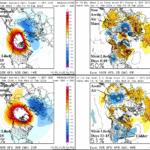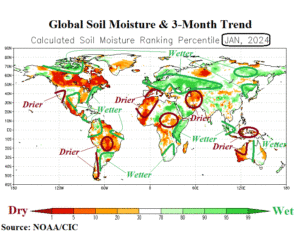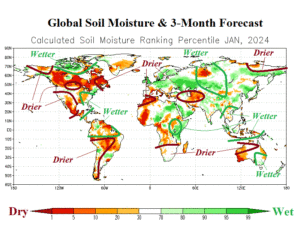
Colder Pattern Change U.S. But Arctic Air In-Doubt For Now
02/06/2024, 8:26 am ESTTracking Mid-February Arctic Air
02/11/2024, 10:02 am ESTExecutive summary: Strengthening drought was observed during NOV/DEC/JAN 2023-24 in Central Brazil, Northwest Africa, the Middle East, and Central Indonesia. El Nino 2023-24 has shifted past the mature stage. The outlook is for rapid deceleration to neutral ENSO during MAR/APR/MAY 2024. Drought concern, as middle of 2024 approaches, is highest across Central Brazil to Chile, the Middle East, and South Africa. A climate pattern change to a wetter scenario is projected for Southeast Asia and Indonesia. In the U.S., the Midwest States are likely borderline wet while the southern Canadian Prairies trend drier.

Fig. 1: The January 2024 global soil moisture anomalies and 3-month trend.
Observation discussion: During NOV/DEC/JAN 2023-24, the Canadian drought continued although Northern Canada is wetter (Fig. 1). In the U.S., prior to the current “atmospheric river” historic rain and snow, California and the Southwest U.S. were trending drier. Texas, the southern Great Plains, and (thankfully) the Mississippi River Valley were trending wetter. The low water on the Mississippi River has eased. The U.S. East Coast stormy winter season has turned soil moisture wetter than normal. To the north of the Panama Canal, much needed wetter conditions developed into the New Year. In South America, Central Brazil drought worsened while the Argentina drought ended. Entering February, Argentina has turned sharply drier again. Chile long-term drought is re-intensifying and a catalyst to recent fatal fires in that country. The Europe 2023 drought has dissipated due to a wetter than normal winter season. However, Northwest Africa drought stretches to coastal East Spain, South France, and Italy. South and Northeast Africa trend wetter. A large drought continues to strengthen in Iran/Iraq. Western Indonesia turns wetter while southwest Indonesia drought continues, and Central/East Indonesia drought worsens. Eastern Australia turns wetter despite the usual dry climate El Nino produces. Northwest Australia dryness strengthens.

Fig. 2: The January 2024 global soil moisture anomalies and 3-month trend.
Forecast discussion: The outlook through MAR/APR/MAY 2024 maintains the Canadian drought with a drier climate possible for the southern Canadian Prairies and Quebec (Fig. 2). The Northern Canada wetter trend expands. In the U.S., California, Southwest U.S., and Northwest Mexico trend drier. The Southeast U.S. is wet and the wet tendency backs westward into the Midwest States. Central America to northwestern South America is wetter than normal. Improvement in the Panama drought condition is expected. Central Brazil to Peru and southward across Chile trend drier. The Europe soil moisture conditions are largely unchanged. The Northwest Africa drought worsens. Drought expansion is forecast for the Middle East while a new drought emerges in South Africa. Northeast wet soil conditions advance westward. A large area of wetter climate is forecast for Central Russia while Southeast Asia to Indonesia observe a wetter climate pattern. In Australia, southeastern sections trend wetter while the northwest is drier. During MAR/APR/MAY 2024 an El Nino deceleration into neutral ENSO is expected. In the Indian Ocean, the Indian Ocean dipole (IOD) reverses toward negative phase.
